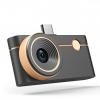
Breaking News
 2025 Annual Shareholder Meeting | Tesla
2025 Annual Shareholder Meeting | Tesla
 Tesla, Google, Nvidia and Starcloud in a AI Space Race. Tesla Future Chips, SpaceX Starship are Key
Tesla, Google, Nvidia and Starcloud in a AI Space Race. Tesla Future Chips, SpaceX Starship are Key
 DHS Considering Private Bounty Hunters for Immigration Enforcement
DHS Considering Private Bounty Hunters for Immigration Enforcement
 BREAKING: Supreme Court Allows Trump To Block SNAP Benefits
BREAKING: Supreme Court Allows Trump To Block SNAP Benefits
Top Tech News
 HUGE 32kWh LiFePO4 DIY Battery w/ 628Ah Cells! 90 Minute Build
HUGE 32kWh LiFePO4 DIY Battery w/ 628Ah Cells! 90 Minute Build
 What Has Bitcoin Become 17 Years After Satoshi Nakamoto Published The Whitepaper?
What Has Bitcoin Become 17 Years After Satoshi Nakamoto Published The Whitepaper?
 Japan just injected artificial blood into a human. No blood type needed. No refrigeration.
Japan just injected artificial blood into a human. No blood type needed. No refrigeration.
 The 6 Best LLM Tools To Run Models Locally
The 6 Best LLM Tools To Run Models Locally
 Testing My First Sodium-Ion Solar Battery
Testing My First Sodium-Ion Solar Battery
 A man once paralyzed from the waist down now stands on his own, not with machines or wires,...
A man once paralyzed from the waist down now stands on his own, not with machines or wires,...
 Review: Thumb-sized thermal camera turns your phone into a smart tool
Review: Thumb-sized thermal camera turns your phone into a smart tool
 Army To Bring Nuclear Microreactors To Its Bases By 2028
Army To Bring Nuclear Microreactors To Its Bases By 2028
 Nissan Says It's On Track For Solid-State Batteries That Double EV Range By 2028
Nissan Says It's On Track For Solid-State Batteries That Double EV Range By 2028
DARPA Liberty Lifter aims to bring back heavy-lift ground effect seaplanes

Prototypes could fly as early as 2027.
The wing-in-ground effect has seen a bit of a mini revival over the last few years. There are a few players trying to get ground effect vehicles (GEVs) into commercial circulation – notably Singapore's Wigetworks, with its Airfish-8 and Boston's Regent, which has drawn in considerable funding and pre-sales to build a prototype of its fully electric, 12-passenger Viceroy seagliders.
All of these aircraft, as well as the Liberty Lifter and Russia's famous WW2 Ekranoplan program, aim to make use of a neat bit of physics: when a plane flies very close to the ground – at an altitude less than half of its own wingspan – it can ride on a cushion of high-pressure air between the wing and the surface, gaining additional lift while reducing lift-induced drag. This can make these things extremely efficient – flying at an altitude around 5 percent of the wingspan can get you from A to B up to 2.3 times more efficiently.
DARPA likes the idea because ground-effect seaplanes could get big, heavy cargo from A to B much faster than ships, without the need for large ports, or the enormous runways and ground-based logistics required by large cargo planes. A Liberty Lifter could take off from any given body of water, and put down on any other, without any infrastructure requirements, greatly simplifying the logistics of moving big, heavy military gear around the place.
For the Liberty Lifter program, DARPA is looking for designs that are:
Capable of taking off and landing at low speeds on turbulent seas
Capable of carrying payloads over 100 tons
Capable of delivering operational range figures over 7,500 km (4,660 miles)
Capable of operating at sea for weeks at a time without needing land-based maintenance
Capable of reducing the risk of collisions when operating at high speeds in congested areas
Cheap to build, using low-cost materials rather than exotic, lightweight materials
Capable of sensing and avoiding large waves, and intelligently handling the takeoff and landing processes accordingly

 Carbon based computers that run on iron
Carbon based computers that run on iron

